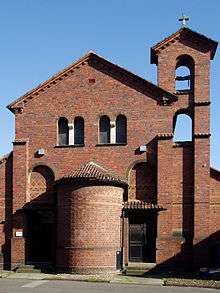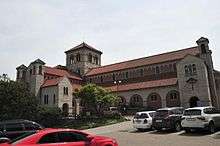Arthur Stansfield Dixon
Arthur Stansfeld Dixon (26 August 1856 – 8 January 1929) was an English metal worker and architect.


Born in Edgbaston, Birmingham, he was the eldest son of education reformer and MP George Dixon. He founded the Birmingham Guild of Handicraft and designed their headquarters in Great Charles Street. The building is still extant, but converted to offices.[1]
He also designed the Romanesque style, brick-built Church of St John & St Basil (1910–1911) in Heath Mill lane in the city's Digbeth district (52.4769°N 1.8813°W). It was described by Nicholas Pevsner as "the finest example of his Arts and Crafts primitivism".[1] A further church design was St Andrew’s Church, Barnt Green, Worcestershire (52.3604°N 1.9880°W).[1]
In 1917 he was commissioned to design Seoul Anglican Cathedral in Korea; construction began in 1922 but was only completed in 1996 after the original plans were rediscovered.[1]
In 1923 along with Holland W. Hobbiss he helped to design the rebuild of St Giles Church, Rowley Regis after it was burned downed. It is the 4th building on that site.
His son James, serving in the Royal Warwickshire Regiment during World War I, was killed aged 22.[1]
Pevsner described Dixon as "an Anglo-Catholic Socialist who associated Gothic with establishment conservatism and dreary Anglican piety".[1]
References
- Turner, Joe (4 February 2014). "Arts & Crafts Architecture in Birmingham II: AS Dixon & the Birmingham Guild of Handicraft". Birmingham Conservation Trust. Retrieved 12 February 2014.
External links
| Wikimedia Commons has media related to Arthur Stansfield Dixon. |